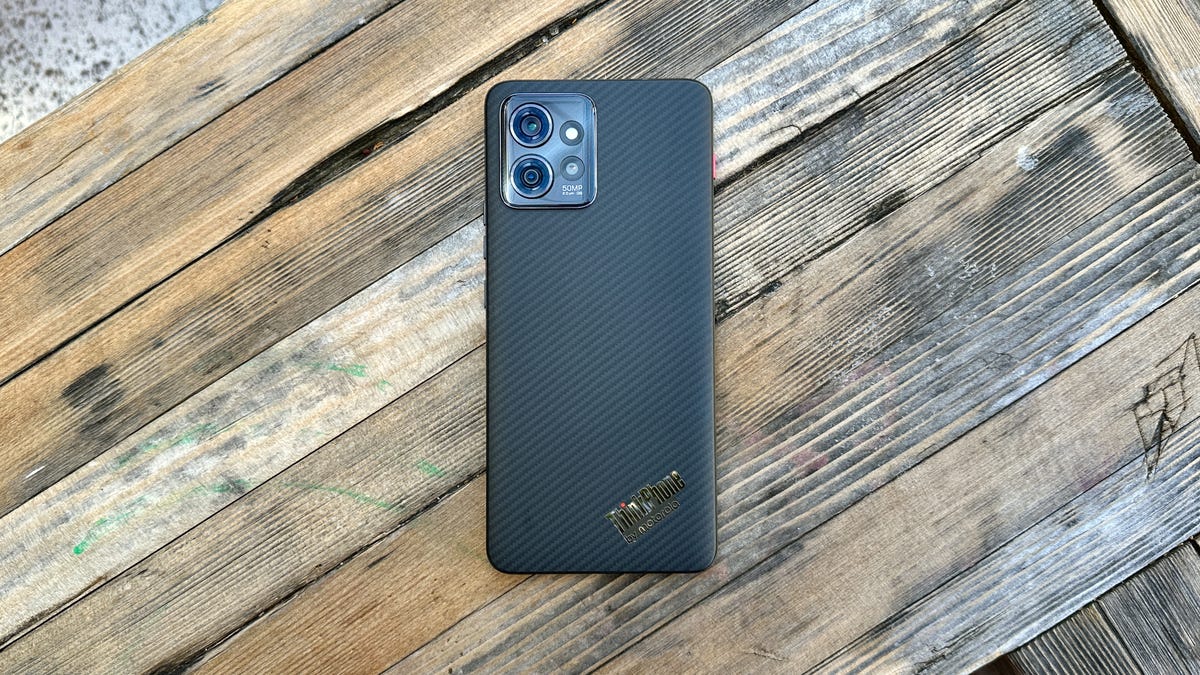
The Lenovo ThinkPhone by Motorola was first announced at CES earlier this year. Motorola is known for its well-thought line of affordable phones, while its parent company has made a name for itself with its ThinkPad line of laptops. And that’s one of the reasons the ThinkPhone is so compelling as a product. It combines Motorola’s deep history of making Android phones with Lenovo’s Windows wisdom.
The ThinkPhone is aimed at business types who value productivity and workflow. It’s now available to enterprise customers via Lenovo’s business sales channels. The ThinkPhone will also be sold unlocked to consumers starting April 28 for $700 (which converts roughly to £565, AU$1,060) on Motorola’s website as well as Lenovo’s site.
My colleague Patrick Holland has been testing the ThinkPhone, and you can read his hands-on impressions with it here, with the original article appearing below.
Hands-on with the Lenovo ThinkPhone
The ThinkPhone runs a lightly skinned version of Android 13.
I’ve been using the ThinkPhone for the past several days, and I’m impressed so far. For a new phone that’s likely the first in a new product line, it’s very mature. The phone’s design definitely mimics the business look of a ThinkPad. On the back, there’s even a ThinkPhone by Motorola badge on the bottom right corner of the phone like a ThinkPad logo on Lenovo’s laptop. The diagonal aramid fiber weave inlay on the back gives the phone a sophisticated look.
The ThinkPhone comes with a minimal plastic case and a 68-watt wall charger. And that charger might be my favorite part of the phone so far. In addition to having a hefty 5,000-mAh battery, the ThinkPhone can charge fast. I plugged it into the wall and it went from an empty battery to 92% in 30 minutes, making it one of the fastest-charging phones sold in the US. For perspective, the similarly priced iPhone 14 only added 42% in the same amount of time.
The main camera is good, especially in bright lighting. There’s a step down in quality when taking photos in dimmer environments, but snaps still look decent. I still have more testing to do with the cameras, but take a look at a few photos below.
The main camera captures good detail. Note the names of the books.
The dynamic range is decent, but the ThinkPhone definitely crushes shadows. Notice the seating area.
The phone nailed the colors in this photo.
But the most exciting thing about the ThinkPhone is the seamless way it works with a Lenovo ThinkPad. For example, I can copy and paste text and photos from the phone to the laptop or use the ThinkPhone’s 50-megapixel camera for a video call on the ThinkPad. While cross-platform compatibility features isn’t unique to Motorola and Lenovo, they work closer to what Apple does with its iPhone and Mac than other Android and Windows devices. I still have a lot more to explore, but check back for my full review.
Lenovo ThinkPhone features and design
The ThinkPhone brings together Android and Microsoft Windows through Lenovo specific features.
The ThinkPhone has a similar design aesthetic as Lenovo’s popular ThinkPad laptop line, down to the signature red button. Motorola and Lenovo focused on three specific areas for the business-focused ThinkPhone: security, durability and productivity.
Among the ThinkPhone’s most interesting features is its customizable red key, which can be used to launch certain apps or features, such as the Walkie Talkie functionality in Microsoft Teams. It sounds similar to the programmable button on Samsung’s XCover6Pro, a phone that was also developed for enterprise and industrial uses.
It’s a work-oriented device, so the ThinkPhone unsurprisingly includes a variety of productivity features that make it easier to connect the phone to your PC. Many of these features are already available through Motorola’s existing Ready For software, which you can find on previously launched phones like the Motorola Edge 20 and Edge 20 Plus. These include the ability to use the ThinkPhone as your laptop’s webcam for video calls, automatic connectivity to your Windows laptop via Wi-Fi when it’s nearby, drag-and-drop file transfers between the ThinkPhone and your Windows computer and a unified clipboard. The difference, however, is that you can access some of these features with the ThinkPhone’s red key, making it stand out from Motorola’s other devices.
The ThinkPhone by Motorola next to a ThinkPad laptop.
Motorola is also positioning the ThinkPhone as ideal for storing sensitive work-related information. The device has a separate processor called Moto KeySafe, which isolates PINs, passwords and other sensitive data. Lenovo and Motorola’s ThinkShield and Moto Threat Defense software can also be found on the device. The ThinkPhone also has tools that allow IT departments to manage lock screen settings, network alerts and other aspects of the device.
The ThinkPhone is MIL STD 810H certified and is constructed from an aramid fiber that Motorola says is stronger than steel. It also has Gorilla Glass Victus and should be able to withstand drops from up to 1.25 meters. Like most modern phones, the ThinkPhone has IP68 water-resistance.
Many of the ThinkPhone’s other specifications are similar to the ones found on standard flagship smartphones. The phone has a 6.6-inch display, Android 13 and runs on Qualcomm’s Snapdragon 8 Plus Gen 1 processor. There’s a 50-megapixel main camera and a 13-megapixel ultrawide camera along with a 32-megapixel selfie camera.
Watch this: Best of CES 2023: All the Best Tech We Saw
